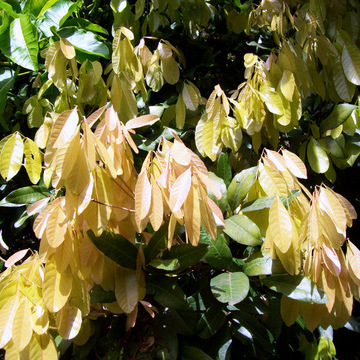Trees or rarely shrubs. Indumentum of solitary, simple hairs; glandular scales always absent in the Malesian species. Twigs terete, smooth to slightly rough, hairy at least when young. Leaves spirally arranged, paripinnate, 1-6-jugate, without pseudo-stipules; petiole (hemi)terete, pulvinate; rachis (hemi)terete; petiolules usually consisting of a pulvinus only, usually 1-grooved. Leaflets opposite to subopposite, rarely alternate, symmetric, usually not falcate, margin entire to slightly répand, not revolute, both surfaces smooth; domatia usually present in axils of major nerves, rarely completely absent. Inflorescences axillary to pseudoterminal, rarely ramiflorous; bracts and bracteoles triangular, outside hairy, inside usually glabrous; pedicels hairy. Flowers seemingly bisexual, probably functionally unisexual. Calyx 5-dentate to-partite, teeth triangular to ovate, apert to narrowly imbricate, all equal, rarely slightly unequal, margin entire. Petals (2-)5(-6), slightly longer to slightly shorter than the calyx; scales present, rarely completely absent, free or adnate to margin, or enation of margin, not crested. Disc complete, glabrous or hairy. Stamens 8 (6-10); filaments at least basally pilose; anthers pilose or glabrous. Ovary sessile, 2-or 3-locular, smooth, hairy; stigma apical, not lobed, with 2 or 3 stigmatic lines, or 2-or 3-lobed with lobes distinctly recurved in fruit. Ovules 1 per locule. Fruits with 1-3 well-developed lobes, loculicidal, central axis not thickened transversely, [in A. bullata and A. macrobotrys opening irregularly (loculicidal), central axis thickened transversely,] short-or long-stipitate, dissepiments complete, lobes laterally not or slightly flattened; exocarp thick, coriaceous, mesocarp thick, coriaceous to woody, endocarp thin, chartaceous, hairy at least on sutures of carpels (in A. bullata and A. macrobotrys thick, radially striate from the attachment of the seed up to ½-⅔ the height of the fruit, not covering the sutures or the fruit axis, sclerenchymatous, detaching from the fruit wall when mature, glabrous). Seeds (partly) covered by an apically open arillode, consisting of 1 or 2 layers, the outer or only one soft, yellow, the inner one firm, dark brown when dry; hilum basal; sclerotesta rather thin, coriaceous, endotesta even thinner, more membranous.
More
Trees, monoecious. Branchlets usually pale, lenticellate; indumentum of simple hairs. Leaves paripinnate; leaflets opposite to alternate; lamina usually with prominent lateral veins and parallel cross veins; domatia usually present along midrib. Inflorescence usually axillary, raceme-like or panicle-like; cymules stalked. Flowers regular. Calyx cupular, deeply 5-lobed; lobes ovate. Petals 5, usually clawed; scales crestless. Disc complete. Stamens 6–8, filaments filiform, hairy. Ovary 2-or 3-lobed or not lobed, 2-or 3-locular; ovule 1 per locule; style short; stigmas toothed or lobed. Fruit 1–3-lobed, 2-valved, or not lobed, loculicidally or irregularly dehiscent; pericarp thin or thinly fleshy; valves drying thin, crustaceous. Seed obovoid; aril thinly fleshy, usually enclosing seed. [Description to be revised, currently includes Mischarytera]
Trees, rarely shrubs, monoecious or dioecious. Leaves paripinnate, alternate, estipulate; leaflets entire, domatia usually present in axils of major veins. Thyrses axillary; bracts and bracteoles small. Flowers unisexual, actinomorphic. Calyx cupular, 5-lobed; lobes valvate. Petals (4 or)5, nearly as long as or slightly shorter than calyx, clawed, with 2 scales adaxially. Disk annular, entire or sometimes lobed. Stamens (male flowers) (7 or)8(-10), exserted; filaments filiform, hairy. Ovary (female flowers) obovoid, 2-or 3-loculed; ovules 1 per locule; style 2-or 3-lobed at apex. Capsules lobed into 2 or 3 schizocarps, usually only 1 or 2 developed, fertile schizocarps loculicidal, pericarp leathery. Seeds with crustaceous testa, wrapped with arillode; embryo curved.

